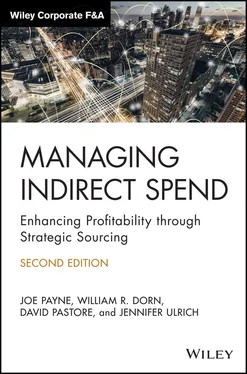Third, a lack of market insight inclines you toward mimicking the methods and obtaining the results of whoever sourced the category before you. Without the Research phase, you may feel tempted to consult the documentation, employ the methods, and seek the results available to you. This ignores, however, that markets are fluid, changing constantly. New technologies, new products, or new competitors may have emerged since the last time you sourced categories related to the product. Alternative processes, sourcing tools, or services may be available that have not been considered before. Without market research, these opportunities can easily be overlooked.
Each spend category necessitates a different type and amount of research. However, you should explore some general elements during the Research phase of any Strategic Sourcing initiative:
Identifying suppliers
Understanding supply chains
Understanding market conditions
Understanding the factors of cost
Reviewing available technologies
Reviewing alternative processes
Reviewing alternative products and services
Performing a want‐versus‐need assessment
Perhaps the most important step in the Research phase is supplier identification. It simply would not be possible to engage in a Strategic Sourcing initiative without a supply base. Oftentimes, however, professionals do not take as much time to identify suppliers as they should. Identifying suppliers can be a tedious task—a wealth of information is available online, but it's often overwhelming in scope and difficult to sort through. In an effort to save time (and sanity), many professionals adhere to the three‐bid rule, meaning they only ask three suppliers to provide a quote. The three‐bid concept normally ensures you are not getting completely gouged with poor pricing, but it by no means ensures you are going to get the best price or service.
Others identify more than three suppliers but may choose to arbitrarily exclude certain suppliers from their list. For instance, if an end user expressed that a certain supplier used to have the business, but that the relationship ended due to a dispute or even just a poor experience, you may be tempted to avoid the supplier. However, former suppliers often have good insight into the needs of your organization, and over time, they may have taken efforts to correct the issues that had resulted in their termination. If nothing else, they may be able to provide some previously unrealized insights into the markets in question.
Similarly, for common or well‐understood categories, it's easy to be lured into the trap of only including the well‐known suppliers or only those who have already been aggressively pursuing your organization's business. This often means missing out on suppliers who could be a perfect match. When a satisfactory quantity of suppliers is identified, research is discontinued, potentially omitting suppliers who could be a great match and may perform best from a cost and service perspective.
Another common problem occurs when organizations prepare an RFI or RFP and send it to dozens of suppliers, but fail to communicate properly with those suppliers. The suppliers who receive an unsolicited bid document with no further communication from the prospective buy may perceive the document as a “phishing” attempt to discover their pricing range for a product or service. In these instances, they won't bother providing a proper response.
Overall, the goal of supplier identification is to create a rather comprehensive list of supplier names, contact information, and other relevant data. During the RFx phase of the initiative, you begin to narrow this down to a short list. Many tools are available that can be used to help identify suppliers, and many of these tools are discussed in Part Two.
UNDERSTANDING THE SUPPLY CHAIN
The question that comes up most often when talking about supply chains is “Who is my supplier's supplier?” These discussions often revolve around the concept of risk and determining how reliable the supplier's supply base is.
When sourcing raw materials, it is particularly critical to understand where the materials your suppliers use are coming from. Generally, in the case of indirect spend, the risk of outage is somewhat reduced—while it may result in inefficiencies in your business, it probably will not stop your business from running. However, there are several reasons beyond just risk to make sure you have a firm understanding of the entire supply chain. Your Research phase is the best time to ask the question, “What type of supplier should we be buying from?”
Each basket of goods or services or individual spend category has its own unique characteristics, and therefore, each has unique types of suppliers that serve the market. The most common types of suppliers that span most categories of indirect spend are local, regional, and national suppliers; manufacturers and distributors; as well as brokers, group purchasing organizations (GPOs), and other third‐party suppliers.
Local, Regional, and National Suppliers
Typically, during a Strategic Sourcing initiative, large companies with multiple locations seek to consolidate their purchasing, particularly for indirect spend categories. If the organization has locations across the country, this means that it is ideal to identify suppliers who can provide nationwide service. If the organization has multiple locations that are all in the same general region, this might entail looking for both national and regional suppliers. If an organization only has one or two locations, and both locations are in the same region, you might be able to consider local suppliers alone.
While consolidation of suppliers generally makes sense in less‐strategic spend categories, it may a substantially higher per‐unit price for certain markets. This is particularly common for products where freight is a major component of cost, such as corrugated boxes, wooden pallets, or light bulbs. Spend categories in which services are unique to particular locations or regions may also contravene a single‐supplier strategy. A good example is janitorial services, for which on‐site presence is required daily.
In order to determine the type of supplier who makes the most sense for your Strategic Sourcing initiative, first look at how the products or services are currently being purchased. Are you currently buying from multiple suppliers across multiple locations? If so, why? It might be because different locations have different requirements or because freight costs make a local source of supply the better option. Of course, it might also mean that there is an opportunity for cost savings through supplier consolidation.
Remember that during the Research phase you are hoping to develop a long list of suppliers that will be refined as you move into the RFx phase. At this stage, including local, regional, and national suppliers on your list is better than limiting it to only one type of supplier, but it is important to understand the differences and distinguish between these supplier types when going to market.
Manufacturers and Distributors
The difference between manufacturers and distributors becomes a consideration when you are purchasing products (as opposed to services). A manufacturer is the organization that actually produces the good you are purchasing. A distributor purchases the goods (normally in large quantities), warehouses them, and then ships them to you (typically in smaller quantities). In the office supplies example used earlier, Staples is a distributor of paper products; however, Staples does not have any facilities that actually produce paper. Instead, the organization buys product from a manufacturer and warehouses it across the country.
Читать дальше












